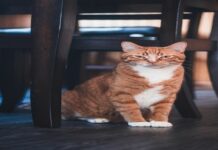The bongo is the third heaviest antelope animal found in rain forest and dense tropical forest of Africa. If you ever found this animal, the first thing you will notice is its white-yellow striking stripes (10-15 in number) on chestnut brown colored coat. Its horns are long and spiraled and they keep their impressive horn throughout their lives unlike deer that shed and grow their horns annually. The wide horns on their head give arresting attribute to the animal. This animal is nocturnal which means it is mostly active between dusk and early dawn and this is the time when they are most vocal too. They are vociferous in nature and can take out myriads of sounds from grunting to snorting, bleating to mooing. Bongos are known to be extremely shy animals. If they notice any human is keenly observing them, they get startled and immediately run away into the wild. There are only few bongos left because of loss of habitat and mass hunting.
Types Of Bongo
There are two categories of bongos
- The Mountain Bongo - It is also known as the eastern bongo. This bongo has more vibrant coat color and stripes than the latter. It is mostly found in the dense forest of central Kenya. The mountain bongo has been specified as critically endangered.
- The Lowland Bongo - It is also known as the Western Bongo. It is mostly found in the dense tropical forest of Africa. This type of bongo is described as on the verge of extinction.
Bongo Animal Characteristics & Information
- Bongos can be seen in dense African forest and central Kenya
- It is herbivores animals and nocturnal in nature
- It is one of the largest and the most distinctive African forest antelope
- The conservation status of the animal is nearly threatened
- The length of the animal is 5.5 - 8.25 ft
- The weight of the animal is 210 - 405 kg
- The length of its tail is 45 - 65 cm
- The lifespan of bongo is up to 19 years
- The coat of the dog is chestnut brown color with white-yellow stripes on it.
- The top speed of the bongo is 70kmph
- The long and heavy spiral horns give distinctive look to the animal.
- Bongos are the only tragelaphid (spiral horned antelope) in which both sexes have horns
- This animal does not use its horns for fighting. They use it to clear bushes on their way
- The bongos have social interaction complexity. They run away immediately they find human.
Facts About The Bongo Animal
- Males are aloof in nature and prefer to live alone while female bongos live in herd
- A female bongo produces one calf per litter
- Few native African tribes do not touch the animal because they think contact may leads to spasm (cramp) in their body
- Bongos polish their horns by covering it in mud and then removing the mud by rubbing against trees
- The gestation period of bongos is similar to humans i.e. 9 months
- Unlike other animals, male or female bongos grows of similar height
- The strip of the bongos helps them to camouflage in the surrounding in order to hide from enemies
- Hunters kill bingos for its meat, horns and skin
- The main natural predator of bongo is leopard.
Appearance
The bongos are large andhefty looking antelope. They have large ears which give them keen sense of hearing. The bongo's legs are short compared to its large upper body. Their legs have horizontal strips of white and black color. The tail is long and have hairy tip (tufted). The tongue is long and prehensile which helps them to grip leaves or fruits placed at higher branch. They also have thin mane which runs from shoulders to back.
Horns
The female have less coiled and shorter horns than males. The twist in the horn can be one or one and a half. The horns of females are lighter in color than those of males. The bongos can push their horns backward and run freely in the wild.
Coat and Color
The bongos have short and glossy coat of chestnut or orange in color. Their coat has 10-15 vertical stripes of white or yellow color. These stripes help them to camouflage in the dense forest. The bongos also have crescent shaped white strip on their side cheeks.
Height and Weight
Both the sexes of bongos are similar in height. The average height of the animal is 3.6 to 4.3 ft and the length is 7.1 to 10.3 ft. The ideal weight of the male breed is 220–405 kg and female weight is around 150–235 kg.
Behavior
Bongos are nocturnal animal. They are extremely shy and tend to run away as soon as they notice any human. Even the researchers are not able to draw out definite conclusion about this animal. Whatever behavior has been observed is through the captive bongo kept in zoo. Male bongo prefers to live in solitary while female bongo live in herd of 10-15 individuals. This animal uses variety of sounds like snorts, grunts, moos and bleat like alarm calls to communicate with each other. Bongos rely on scent, sound and sight to identify their predators and other bongos. Unlike other antelope species bongos lack secretary gland. Bongos tilt their horns back while running in the dense forest. This position leads to a bald spot on their back. Bongos are also good jumpers but they avoid jumping and prefer to walk under or around the hurdle in their way.
Lifespan
Bongos live around 18-19 years. This data is of captive animals. Bongos that are living in wild have their lifespan dependent upon wild creatures that prey upon them.
Diet
Bongos are herbivorous mammal. They rely solely on plants and grass. Bongos are called as gazers as well as browsers. They feed grasses and vegetation growing on the ground. They also feed on leaves and fruits growing at higher level. Bongos have long and prehensile tongue that helps them to grasp food at higher branch of the tree. Bongos also eat tree’s bark which has been burnt by lighting. By eating burnt wood, they gain minerals.
Habitat
Bongos are found in eastern, western as well as central Africa. However, due to deforestation, the animal's habitat is shrinking more and more. Bongos live where the jungle is dense. They can also be found in western Africa where there is bamboo plantation. The population of bongo could also be found in few regions of Kenya. Historically Uganda also had bongos but now they are completely wiped out. Hunting the animal is also the major reason for its extinction.
Predators
Bongos are the food to large varieties of animals including Lions, Leopards and Hyena. Even Python feeds bongo and can engulf it fully. Native tribes living closer to bongo’s habitat are also the major threat to this animal. Human beings kill bongos for its valuable horns, coat and meat. All these predators have left bongos fewer in number.
Bongo’s Reproduction
Bongo’s mating occurs mostly in October and January. Male bongo lives in solitary and only contact female bongo for breeding. Female bongos live in groupfor protection of their children and consist of females only. The gestation period lasts for 9 month. After the gestation period, the mother bongo gives birth to calf in the dense vegetation in order to protect it from predators. She left the child for a week there only but regularly visits it for care and nurture. After the calf has become strong, both mother and child join the group. Bongo’s calves mature faster. Their horn starts growing when they are 3 to 4 month old. Bongo reaches their sexual maturity at the age of 2 and 2.5 years.






